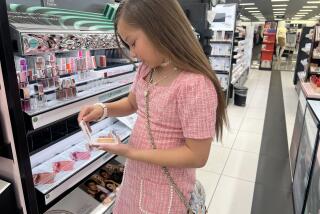Beauty & the Beast.co,
- Share via
Buying makeup on the Internet seems counterintuitive. After all, how can you choose the perfect foundation for your skin from a laptop screen? And aren’t most cosmetics bought on impulse? You go in for mascara and come out with three lipsticks?
Yet, since summer, there’s been an e-commerce explosion in the cosmetics industry. Almost 20 Web sites selling prestige beauty products have launched or are planning to launch this fall: Ibeauty.com, Gloss.com, Eve.com, Beautyscene.com, Beautyjungle.com, even Sephora.com.
And it’s not just retailers. Beauty editors from such prestigious publications as Vogue, Elle and Glamour are hopping aboard to launch online magazines for sales sites.
Cosmetic giants such as Estee Lauder are treading carefully. But smaller, niche brands such as Tony & Tina, Hard Candy and Philosophy are diving in with enthusiasm. One manufacturer is calling the sudden burst of Web activity “the next Gold Rush.”
What a rush it is. Cosmetics, skin care and perfume sales represent a $10-billion-
something industry in the United States alone. And the cosmetics industry is going to keep growing, said Sarah Kugelman, co-founder of Gloss.com. “With people getting busier, they’ll spend $12.50 on shower gel for that moment of relaxation.”
The Web now has an estimated 80 million to 120 million users in the United States. While women have been slow to go online, they are expected to constitute half of all Internet users this year. Women are the main consumers, making 90% of all household purchases.
With Christmas coming, analysts expect $6 billion in U.S. holiday sales--both cyber and traditional shopping--double the $3 billion Americans spent online last year. And, according to the NPD Group, a market research company, 11% of U.S. Internet users say they plan to purchase beauty products online this holiday season.
“This whole beauty e-commerce is totally 1999,” said Andrew Auwerda, president of Tony & Tina, a small, edgy line that is in 125 stores across the country and has had a Web site since 1988. “This is the first cyber-Christmas of prestige color cosmetics that I know of.”
But like a real gold rush, many will be taking financial risks--this is hardly easy money. And it’s possible a few businesses will wash out. Some say this holiday season will be the shake-out point, but analyst Fiona Swerdlow suspects it will take much longer.
“I think it’s much too early for major shakeouts in the beauty arena,” said Swerdlow of Jupiter Communications, a New York-based Internet research firm. “Anyone who’s gone online this year is going to learn an awful lot about traffic spikes, high capacity, customer service, merchandising, fulfillment.”
Consider that Eve.com, online since June, expects to spend $10 million in advertising this year. As one of the first to launch, Eve.com already has what it considers successful figures: 305,000 visits in September, an 80% jump from August. Although only a small percentage of the visitors actually are buying, the volume alone is revealing, said Mariam Naficy, who founded the site with Varsha Rao. “What it tells us is that there is an enormous demand out there for cosmetics online.”
More than 50% of their sales have been for color makeup, even though many observers had predicted the bulk of such online purchases would be bath and skin products or replacement cosmetics. Many consumers also bought smaller brands that are not available in their markets.
This is exactly what small cosmetics companies hoped would happen. Take, for example, Tony & Tina. What if you lived in New Mexico and the closest you could find Tony & Tina was in Dallas? “Driving six hours for lipstick? No one does that,” he said. “[Consumers] want our products. [The Web is] making our brand accessible to everyone in America. There’s no other way for me to do that on a cost-efficient basis.”
Not that going on the Web is easy. Sure, it’s easier than deciding to open a counter in Kansas City. But, he said, Web sales-site partners have to be chosen carefully because their operations ultimately will reflect on Tony & Tina.
Since joining other sites this year, the e-commerce portion of Tony & Tina’s business has jumped from less than 1% in January to slightly less than 5% now. Auwerda expects Web sales to account for 10% of the business next year.
Even with the promise of the Internet, none of the brands can afford to damage their bread-and-butter relationships with retailers. For example, most cosmetics companies will not allow products to be sold more cheaply on the Web than in department stores. And there’s no “gift with purchase” promotions.
All this said, even the big players are realizing they have to be online.
Estee Lauder, the giant among cosmetics companies, is venturing slowly and carefully to maintain control of its brand. It has several lines, including Clinique, Bobbi Brown, Origins, Stila, Prescriptives, M.A.C., Aramis and Aveda and, at this time, only Clinique, Bobbi Brown and Origins have Web sites. A few, including Stila, are expected to go online in the next year.
The reason? “Brand protection--we’re very early on in the medium. The reality is that we have to be just as concerned about protecting our brand and brand equity. A well-done Web site can do a tremendous amount to enhance the brand. A bad one can be detrimental,” said Angela Kapp, vice president and general manager of Estee Lauder’s online operations.
So far, the Lauder sites have been a success. Bobbi Brown, a brand not widely available in most of the country, is getting new business. “Almost 40% of online orders are coming from people who have never used the product before,” Kapp said.
Because Clinique is so widely available, its Clinique.com site has become a place to exchange information. Its customer surveys show that 68% of subscribers get an e-mail about a new product or promotion, then buy it, Kapp said.
Which brings up another counterintuitive aspect. Buying online can be a much more personal experience than buying in a department store.
Said analyst Swerdlow, “People are more engaged when they are shopping online than [when] they are off-line.” For example, Amazon.com has turned book shopping into a personal experience. You can purchase a book, leave a review, read someone else’s or join a cyber book club, she said.
The new beauty sites are pulling out the stops to create a similar experience. On many, a customer can seek advice from a makeup artist, a stylist or a dermatologist. She can determine her skin type and find out which foundations work for her.
Any site worth its weight in stock options has lured a beauty editor away from the New York magazine world. Jean Godfrey-June shocked friends and colleagues when she left a job as beauty and fitness director of Elle to become editor-in-chief for Beautyscene.com.
There were many reasons, she said. For one, magazines work three months in advance. “Now if Demi Moore dyes her hair purple, I can talk about it right away.”
And she can talk about it at any length she chooses. “Unlike a magazine or a book, we have infinite space,” she said. For example, this month’s site subject is acne, and instead of a two-page article, viewers can find screens of information about the subject.
Since her daughter, India, was born two years ago, Godfrey-June has become a fan of the Web. “I have a busy job. To shop for myself, I have to do it at 10:30 or 12 at night,” she said.
Which analyst Swerdlow says is exactly why more and more women will be shopping the Web.
“If you’re talking to the woman who is online today, this is someone who is very busy. She does not have time to drive to the mall and pick up eye cream,” said Swerdlow. “It’s about convenience, not service. If I can do this from my desk at work or at 10 p.m. after I’ve put the children to bed, and I can do that online, that’s a huge draw.”
*
Judging the Sites
* When online cosmetics retal sites are put to the test, snail-mail delivery is the big difference. E3






